Expert could reach brake on crashed Glasgow bin lorry
- Published
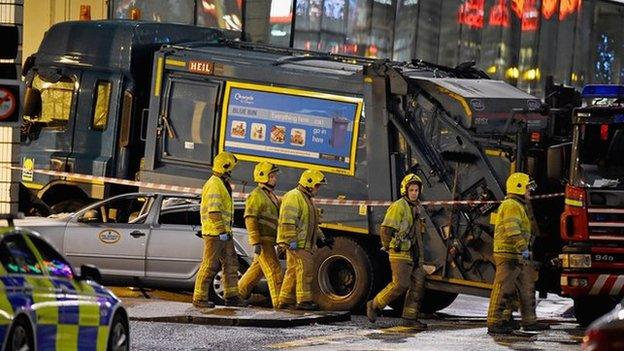
Six people were killed and 10 others injured when the council bin lorry crashed in the centre of Glasgow
An expert witness has told the inquiry into the Glasgow bin lorry crash, which killed six people, that he could reach the handbrake from the rear crew seats.
Vehicle examiner Philip Balderstone said he could reach the brake with his foot - but only by hand when he was standing without a seatbelt on.
The fatal accident inquiry (FAI) has heard two crewmen on board during the crash were seated with their belts on.
The inquiry is examining the lorry, its route and driver Harry Clarke's health.
Mr Balderstone was giving evidence on the third day of the FAI, which is being overseen by Sheriff John Beckett QC at Glasgow Sheriff Court.
The vehicle examination consultant, who works for the Transport Research Laboratory, was asked to produce a report on the bin lorry following the crash on 22 December last year.

(Clockwise from top left) Jack Sweeney, Lorraine Sweeney, Erin McQuade, Jacqueline Morton, Stephenie Tait and Gillian Ewing were killed in the crash
The court has already heard that the front driver section of the lorry cab and the rear crew section was separated by a metal bar.
Mr Balderstone's report noted that the vehicle had an emergency stop button for its rear machinery.
This, however, was not connected to the chassis or drive of the lorry, meaning it could not stop the vehicle.
The court was then shown a picture of Mr Balderstone in the vehicle cab, trying to reach the parking brake control from the rear crew section.
Braking issues
Mr Balderstone confirmed that he was able to reach the brake lever from the rear area and apply it "reasonably easily".
The court has previously heard that the two rear-seated crewmen on the day of the crash, Matthew Telford and Henry Toal, made no attempt to apply the brake and believed they could not reach it.
Mr Balderstone said he is 5ft 8in tall and could reach the parking brake "comfortably".
Solicitor General Lesley Thomson, Scotland's second most senior law officer, who is leading the FAI, then asked if someone who was 5ft 3in tall could reach the brake - this is the height that Mr Telford gave for himself during evidence on Wednesday.
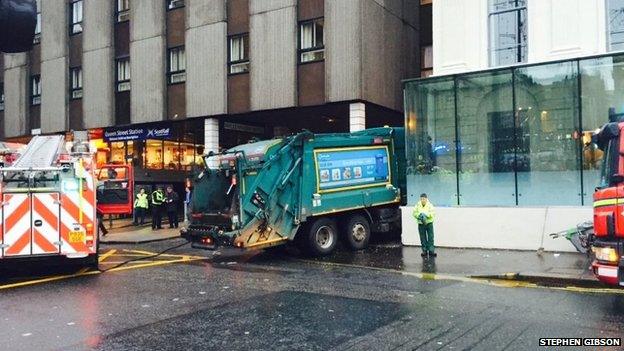
The bin lorry crashed outside Queen Street Station in George Square
Mr Balderstone said it would be more difficult, but could not say for sure if it would be possible.
The court heard that his report recorded the brake as being 0.71m from the top of the metal bar separating the front and rear sections of the lorry cab.
Mr Balderstone said it would be easier to reach the brake by going under the barrier, but this would be less safe.
The witness also said he tried to reach the brake lever while seated, with a belt on and this would only be possible from one seat, to the left of the driver.
He said he could "just" reach the brake lever at "fingertip stretch" after several tries while sitting with the belt on.
Mr Balderstone agreed that the possibility of reaching the brake lever with a seatbelt on, while the vehicle was moving, was "remote".
The witness agreed that in order to reach the brake comfortably, and operate it with their hands, a passenger would need to remove their seatbelt.
Skidding risk
He agreed that anyone doing this would need some training or knowledge of the brake lever in order to use it.
The court previously heard that Mr Telford and Mr Toal were not trained to operate the front controls of the lorry cab and could not drive.
Mr Balderstone said he found it "quite simple" to reach the brake lever and move it with his feet, while seated.
The inquiry heard that if used, the hand brake would not bring the lorry to a controlled stop and could cause it to skid.
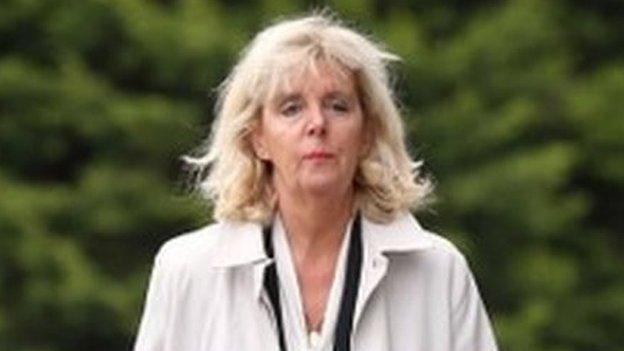
Solicitor General Lesley Thomson is leading the inquiry
Mr Balderstone agreed that it could, however, slow the lorry down if it was the only option available.
The court then heard that in his report, Mr Balderstone looked at the use of an emergency switch lever, the sort commonly fond on trains.
He said: "It would need to be in such a place it is accessible to crew members in an emergency but not in a position they are likely to accidentally trigger it."
The witness said that the emergency brake could be designed and added in such a way that it could operate the full braking system.
Safety options
Mr Balderstone also mentioned in his report new technology, in the making, but that has not been implemented yet, such as facial recognition technology.
The inquiry heard it monitors the position of the driver to detect changes in head and eye movement and sends an alert.
The witness said: "It would need other technologies to act upon this alert and halt the vehicle."
Automatic emergency braking (AEB) was also detailed in the report by Mr Balderstone.
It uses the combination of a camera and radar on a vehicle to monitor what is going on outside.
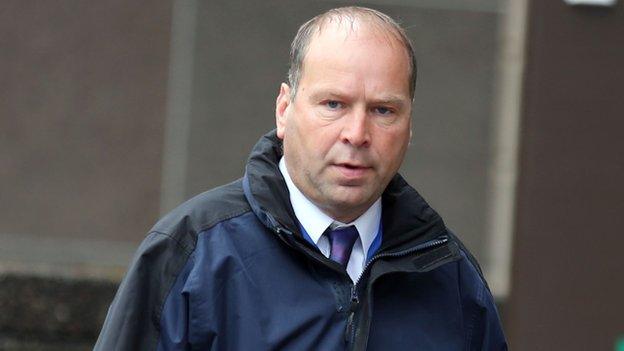
John Stewart said he was told by a bus passenger that Mr Clarke had passed out
In his report the witness said: "Should the driver still not react to the visual and audible warning the AEB has the option of applying varying degrees of autonomous braking in an effort to avoid a collision."
Mr Balderstone later said that AEB systems designed to be fitted to LGVs had no capacity for detecting pedestrians in the path of a vehicle but may do in time.
He added: "Sadly it (AEB) wouldn't have made a difference".
Earlier, the FAI heard a second day of evidence from First Bus inspector John Stewart.
On Thursday, Mr Stewart told the inquiry, about an incident on 7 April 2010 when Mr Clarke had passed out at the wheel of a bus.
No report
The court heard that Mr Stewart had called an ambulance but Mr Clarke was given the all clear by paramedics and refused to go to hospital.
On Friday, the witness was cross-examined by Mark Stewart QC, representing the bereaved Sweeney and McQuade families.
Mr Stewart confirmed that the blackout incident on 7 April 2010 had not been reported to him by Mr Clarke.
He also confirmed that Mr Clarke had driven the bus after the blackout, albeit with no passengers on board.
The witness also said that Mr Clarke had not told him anything about a possible blackout in the bus depot canteen.
Ronald Conway, the lawyer for the bereaved Tait family, then asked the witness about the bus blackout episode.
Mr Stewart said he thought "something might be seriously wrong - that's why I called the ambulance".
The inquiry, which is expected to run for several weeks will examine the medical background, employment record and training of the driver, Mr Clarke.
It will also look at technical aspects of the vehicle and whether any measures could have brought it to a controlled stop, and the safety of the route taken by the vehicle given the time of day and year.
Erin McQuade, 18, her grandparents Jack Sweeney, 68, and his 69-year-old wife Lorraine, all from Dumbarton, died in the incident in the city's Queen Street and George Square.
Stephenie Tait, 29, and Jacqueline Morton, 51, both from Glasgow, and Gillian Ewing, 52, from Edinburgh, were also killed when the truck mounted the pavement before crashing into the side of the Millennium Hotel.
A further 15 people were injured.
The Crown Office has already concluded that there will be no criminal prosecution over the crash, with senior lawyers deeming it a "tragic accident".
- Published23 July 2015
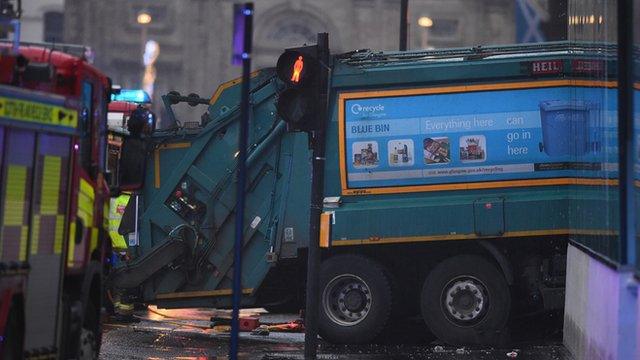
- Published18 June 2015

- Published25 February 2015
